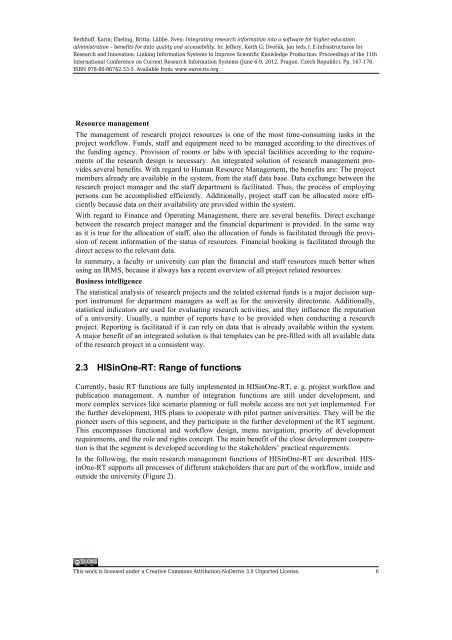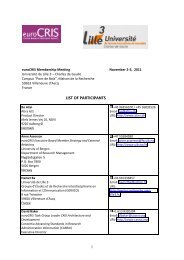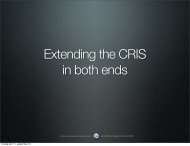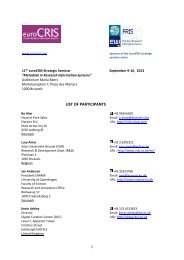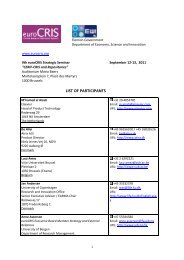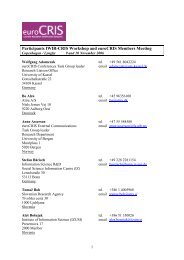Paper - EuroCRIS
Paper - EuroCRIS
Paper - EuroCRIS
You also want an ePaper? Increase the reach of your titles
YUMPU automatically turns print PDFs into web optimized ePapers that Google loves.
Berkhoff, Karin; Ebeling, Britta; Lübbe, Sven: Integrating research information into a software for higher education<br />
administration – benefits for data quality and accessibility. In: Jeffery, Keith G; Dvořák, Jan (eds.): E-Infrastructures for<br />
Research and Innovation: Linking Information Systems to Improve Scientific Knowledge Production: Proceedings of the 11th<br />
International Conference on Current Research Information Systems (June 6-9, 2012, Prague, Czech Republic). Pp. 167-176.<br />
ISBN 978-80-86742-33-5. Available from: www.eurocris.org.<br />
Resource management<br />
The management of research project resources is one of the most time-consuming tasks in the<br />
project workflow. Funds, staff and equipment need to be managed according to the directives of<br />
the funding agency. Provision of rooms or labs with special facilities according to the requirements<br />
of the research design is necessary. An integrated solution of research management provides<br />
several benefits. With regard to Human Resource Management, the benefits are: The project<br />
members already are available in the system, from the staff data base. Data exchange between the<br />
research project manager and the staff department is facilitated. Thus, the process of employing<br />
persons can be accomplished efficiently. Additionally, project staff can be allocated more efficiently<br />
because data on their availability are provided within the system.<br />
With regard to Finance and Operating Management, there are several benefits. Direct exchange<br />
between the research project manager and the financial department is provided. In the same way<br />
as it is true for the allocation of staff, also the allocation of funds is facilitated through the provision<br />
of recent information of the status of resources. Financial booking is facilitated through the<br />
direct access to the relevant data.<br />
In summary, a faculty or university can plan the financial and staff resources much better when<br />
using an IRMS, because it always has a recent overview of all project related resources.<br />
Business intelligence<br />
The statistical analysis of research projects and the related external funds is a major decision support<br />
instrument for department managers as well as for the university directorate. Additionally,<br />
statistical indicators are used for evaluating research activities, and they influence the reputation<br />
of a university. Usually, a number of reports have to be provided when conducting a research<br />
project. Reporting is facilitated if it can rely on data that is already available within the system.<br />
A major benefit of an integrated solution is that templates can be pre-filled with all available data<br />
of the research project in a consistent way.<br />
2.3 HISinOne-RT: Range of functions<br />
Currently, basic RT functions are fully implemented in HISinOne-RT, e. g. project workflow and<br />
publication management. A number of integration functions are still under development, and<br />
more complex services like scenario planning or full mobile access are not yet implemented. For<br />
the further development, HIS plans to cooperate with pilot partner universities. They will be the<br />
pioneer users of this segment, and they participate in the further development of the RT segment.<br />
This encompasses functional and workflow design, menu navigation, priority of development<br />
requirements, and the role and rights concept. The main benefit of the close development cooperation<br />
is that the segment is developed according to the stakeholders’ practical requirements.<br />
In the following, the main research management functions of HISinOne-RT are described. HISinOne-RT<br />
supports all processes of different stakeholders that are part of the workflow, inside and<br />
outside the university (Figure 2).<br />
This work is licensed under a Creative Commons Attribution-NoDerivs 3.0 Unported License. 6


